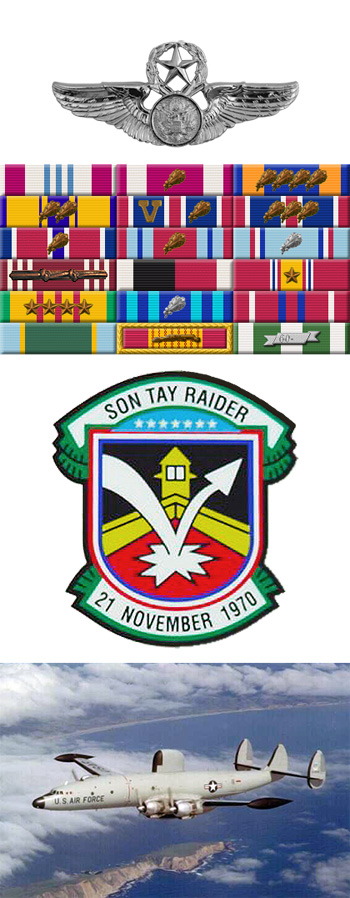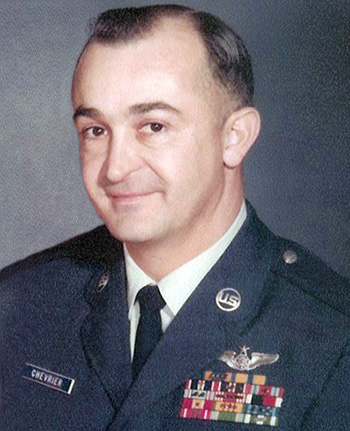
|
Jimmie A. Chevrier, Sr. |
 |
|||
| Rank, Service | ||||
Chief Master Sergeant E-9, U.S. Air Force |
||||
| Veteran of: | ||||
|
||||
| Tribute: | ||||
Jim Chevrier was born on May 5, 1934, in Akron, Ohio. He enlisted in the U.S. Air Force on September 8, 1953, and completed basic training at Sampson AFB, New York, on November 5, 1953. A3C Chevrier next completed Radar Operator training before serving as a Radar Operator and then as an Air Traffic Controller with the 602nd Aircraft Control and Warning Squadron and the 619th Tactical Control Squadron at Birkenfeld, West Germany, from February 1954 until he left active duty in July 1957. After attending the University of Akron for a year, SSgt Chevrier reenlisted in the Air Force on May 29, 1958, and then served as a crew chief of a target simulator crew with the 2626th Combat Crew Training Squadron at Tyndall AFB, Florida, from May 1958 to June 1959. His next assignment was as an Intercept Director Technician with the Grand Forks Air Defense Sector Semi Automatic Ground Environment at Grand Forks, North Dakota, from June 1959 to December 1961, followed by service as a Radar Operator and Assistant Crew Chief with the 932nd Aircraft Control and Warning Squadron at Rockville, Iceland, from December 1961 to December 1962. MSgt Chevrier served as an Airborne Radar Operator, Assistant Crew Chief, and Crew Chief on the EC-121D/T Warning Star aircraft with the 552nd Airborne Early Warning and Control Wing and the 963rd Airborne Early Warning and Control Squadron at McClellan AFB, California, from January 1963 to June 1971. During this time, he participated in Operation Gold Digger during the Cuban Missile Crisis; operations in Europe during the Berlin Crisis; Operation Big Eye at Tan Son Nhut AB, South Vietnam, from February to June 1966; Operation College Eye at Ubon, Udorn, and Korat Royal Thai AFB, Thailand, from July to November 1967; Operational Testing of the EC-121T at Korat RTAFB in August 1970; and Operation Ivory Coast as support aboard the EC-121T Frog One for the Son Tay Raid, a clandestine mission to free American Prisoners of War in North Vietnam on November 21, 1970. After completing the Space Track Surveillance Course at Keesler AFB, Mississippi, MSgt Chevrier served as a Crew Chief, NCOIC of Training, NCOIC of Operations, and as 1st Sergeant with the 16th Surveillance Squadron at Shemya AFS, Alaska, from June 1971 to June 1972, followed by service as Operations Superintendent and Weapons Controller Technician with the 665th Air Defense Group at Calumet AFS, Michigan, from June 1972 to December 1973. He attended the Senior NCO Academy at Gunter AFB, Alabama, from May to July 1973, and then served as Operations Superintendent for Air Surveillance Technician flight testing on the E-3 Sentry Airborne Warning and Control System (AWACS) with the 4628th Air Defense Squadron at the Boeing Company in Seattle, Washington, from January 1974 to May 1977. CMSgt Chevrier next served as Operations Superintendent, Air Surveillance Technician, Trainer and Evaluator, and Unit 1st Sergeant for the E-3 AWACS Follow On Test and Evaluation Team at Tinker AFB, Oklahoma, from May 1977 to September 1978. His final assignment was as Aerospace Control/Warning and Electronics Countermeasures Superintendent and Unit 1st Sergeant for the Combat Operations Center with Detachment 1, North American Aerospace Defense Command, from September 1978 until his retirement from the Air Force on May 1, 1980. He was awarded the Master Aircrew Member Badge and amassed over 6,300 flying hours in the EC-121D/T and E-3A during his Air Force career. |
||||
|
||||

